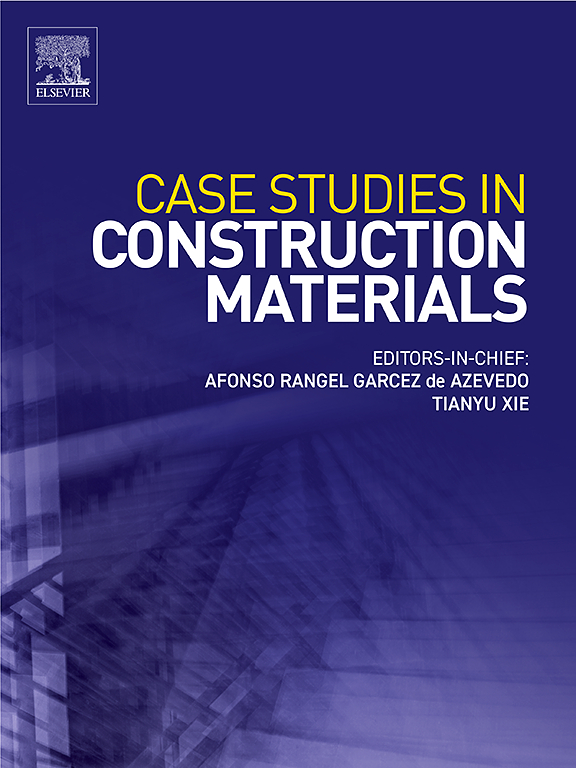Machine learning-based modelling and analysis of carbonation depth of recycled aggregate concrete
IF 6.5
2区 工程技术
Q1 CONSTRUCTION & BUILDING TECHNOLOGY
引用次数: 0
Abstract
This paper used machine learning to model the prediction of carbonation depth and the analysis of feature parameters for recycled aggregate concrete (RAC). Specifically, a database containing 579 sets of RAC carbonation test data was developed. Twelve parameters representing material characteristics and environmental conditions were input, along with one output parameter. On this basis, six machine learning models were employed to predict RAC carbonation depth: Artificial Neural Network, Decision Tree, Support Vector Regression, Random Forest, Extreme Gradient Boosting, and Light Gradient Boosting. Different types of analysis, including statistical measures, shapley additive explanations (SHAP) sensitivity analysis, SHAP parametric study, and comparison study, were used to examine the performance of the developed models and the effects of the input parameters on predictions. The results show that the extreme gradient boosting (XGB) model exhibited the highest accuracy with an R² of 0.99 and a mean absolute percentage error (MAPE) of 6.632 on the training set, and an R² of 0.953 and a MAPE of 13.243 on the test set. The variable importance analysis shows that the carbonation depth for RAC was determined by both internal and external factors. The top five factors impacting RAC carbonation depth are exposure time, water-to-binder ratio, CO2 concentration, coarse aggregate density, and cement content. RAC carbonation depth correlates positively with the former three factors. In contrast, it exhibits a negative correlation with the remaining two variables. In addition, a graphical user interface (GUI) for RAC carbonation depth prediction was designed.
基于机器学习的再生骨料混凝土碳化深度建模与分析
本文利用机器学习对再生骨料混凝土(RAC)的碳化深度预测和特征参数分析进行了建模。具体而言,建立了包含579组RAC碳酸化试验数据的数据库。输入十二个代表材料特性和环境条件的参数,以及一个输出参数。在此基础上,采用人工神经网络、决策树、支持向量回归、随机森林、极端梯度增强和轻梯度增强6种机器学习模型预测RAC碳酸化深度。采用统计测量、shapley加性解释(SHAP)敏感性分析、shapley加性解释参数研究和比较研究等不同类型的分析来检验所建立模型的性能以及输入参数对预测的影响。结果表明,极端梯度增强(XGB)模型在训练集上的准确率为0.99,平均绝对百分比误差(MAPE)为6.632;在测试集上的准确率为0.953,平均绝对百分比误差(MAPE)为13.243。变量重要度分析表明,RAC碳酸化深度由内外因素共同决定。影响RAC碳化深度的前五大因素是暴露时间、水胶比、CO2浓度、粗骨料密度和水泥含量。RAC碳酸化深度与前三个因素正相关。相反,它与其余两个变量呈负相关。此外,设计了RAC碳酸化深度预测的图形用户界面(GUI)。
本文章由计算机程序翻译,如有差异,请以英文原文为准。
求助全文
约1分钟内获得全文
求助全文
来源期刊

Case Studies in Construction Materials
Multiple-
CiteScore
7.60
自引率
19.40%
发文量
842
审稿时长
63 days
期刊介绍:
Case Studies in Construction Materials provides a forum for the rapid publication of short, structured Case Studies on construction materials. In addition, the journal also publishes related Short Communications, Full length research article and Comprehensive review papers (by invitation).
The journal will provide an essential compendium of case studies for practicing engineers, designers, researchers and other practitioners who are interested in all aspects construction materials. The journal will publish new and novel case studies, but will also provide a forum for the publication of high quality descriptions of classic construction material problems and solutions.
 求助内容:
求助内容: 应助结果提醒方式:
应助结果提醒方式:


